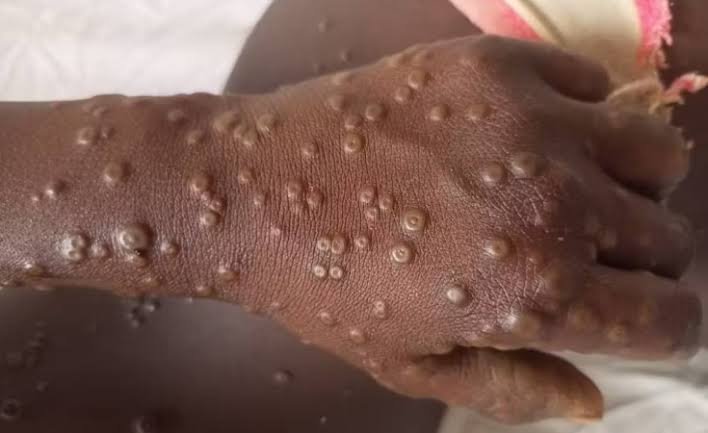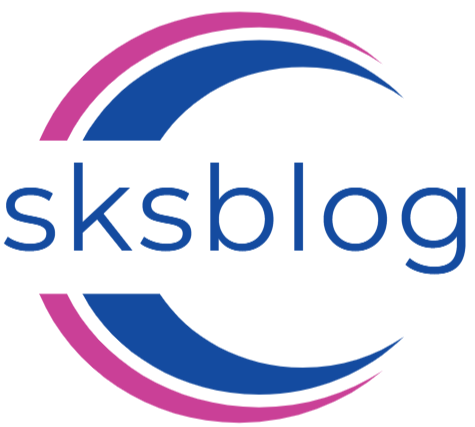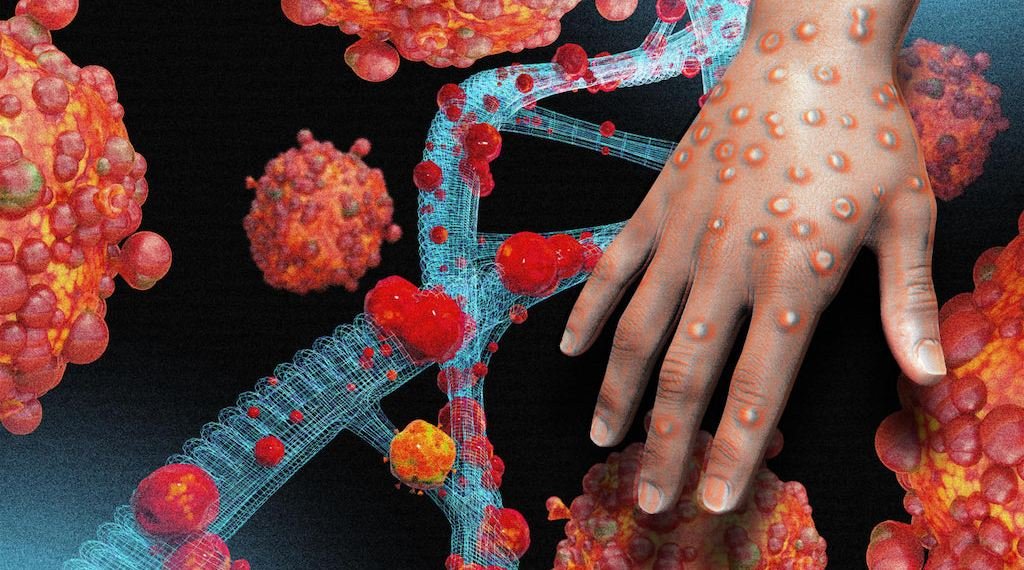Mpox (Monkey pox) is a contagious disease caused by the monkeypox virus. It might lead to a severe rash, swollen lymph nodes, and fever. Most people recover completely, but a few become critically sick.
Table of Contents
OverView :
Anyone can get mpox. It spreads from contact with infected:
- persons, through touch, kissing, or sex
- animals, when hunting, skinning, or cooking them
- materials, such as contaminated sheets, clothes or needles
- pregnant persons, who may pass the virus on to their unborn baby.
If you have mpox:
- Tell anyone you have been close to recently
- Stay at home until all scabs fall off and a new layer of skin forms
- Cover lesions and wear a well-fitting mask when around other people
- Avoid physical contact.
The Mpox ( Monkey pox) virus (abbreviated as MPXV) is an enveloped double-stranded DNA virus of the Orthopoxvirus genus in the Poxviridae family, which also includes variola, cowpox, vaccinia, and other viruses. The virus has two genetic clades: I and II.
The Mpox ( Monkey pox) virus was discovered in Denmark in 1958 in monkeys housed for study, and the first human case of mpox was a nine-month-old boy in the Democratic Republic of the Congo (DRC, 1970). Mpox can be transmitted from person to person or, on rare occasions, from animal to human. Following the eradication of smallpox in 1980 and the discontinuation of smallpox vaccine worldwide, mpox progressively spread throughout central, eastern, and western Africa. A global outbreak occurred from 2022 to 2023. The virus’s natural reservoir is unknown; nonetheless, tiny mammals like squirrels and monkeys are susceptible.
Transmission of monkeypox

Mpox ( Monkey pox) transmitted in several ways:
Human-to-Human Transmission
- Direct contact refers to touching an infected person’s rash, scabs, or body fluids.
- Respiratory Droplets: Prolonged face-to-face contact, such as talking or breathing near someone who has mpox.
- Contaminated Materials: Contact with things, fabrics, and surfaces used by someone who has mpox, such as clothing, bedding, or towels.
Animal-to-Human Transmission
- Direct Contact: Being bitten or scratched by an infected animal, such as small mammals in areas where mpox is endemic.
- Contaminated Animal Products: Contact with infected animals’ fluids or feces.
Prevention Tips
- Avoid Close Contact: With sick people or animals.
- Hand hygiene and surface disinfection should be practiced on a regular basis.
- Vaccination: Smallpox immunizations can help protect against mpox.
What are the symptoms of Mpox ( Monkey pox) ?
Mpox ( Monkey pox) days of exposure and continue for 2 to 4 weeks. Here are the main symptoms:
Initial Symptoms
- Fever
- Headache
- Muscle Aches
- Back Pain
- Low Energy
- Swollen Lymph Nodes
Rash
- Appearance: The rash often appears 1-3 days after the fever begins.
- Progression: It starts on the face and extends to other regions of the body, such as the palms of the hands and soles of the feet.
- Stages: The rash progresses from flat lesions to raised bumps, then to fluid-filled blisters, and lastly to scabs that come off.
Other Symptoms
- Chills
- Exhaustion
The rash and lesions can be highly painful and may leave scars after healing. If you observe any of these symptoms, you should consult a doctor right away.
Treatment and vaccination

Treatment for Mpox (Monkeypox)
There is no specific therapy for Mpox ( Monkey pox) . although supportive care can help relieve symptoms. Here are some important points:
- Symptom Management: Pain relievers and fever reducers can help with symptoms such as fever and muscle pain.
- Hydration: Drinking enough fluids to stay hydrated. Skin care involves keeping the skin clean and dry, as well as applying antiseptic solutions to avoid secondary infections.
- Isolation: To prevent the virus from spreading, infected individuals should be isolated.
Antivirals
- Tecovirimat (TPOXX): An antiviral medication approved for the treatment of smallpox, which can also be used for mpox in certain cases.
- Cidofovir and Brincidofovir: Other antivirals that may be used under specific circumstances.
Vaccination
- Smallpox Vaccines: Vaccines developed for smallpox, such as ACAM2000 and JYNNEOS (also known as Imvamune or Imvanex), can provide protection against mpox.
- Post-Exposure Prophylaxis (PEP): Vaccination after exposure to the virus can help prevent the onset of the disease or reduce its severity.
- Pre-Exposure Prophylaxis (PrEP): Vaccination for individuals at high risk of exposure, such as healthcare workers and laboratory personnel.
Preventive Measures
- Avoid: Contact with diseased people or animals.
- Hand hygiene and surface disinfection should be practiced on a regular basis.
- Protective Equipment: When caring for infected people, use personal protective equipment (PPE).
Self Care and Prevention :
According to WHO Most people with Mpox ( Monkey pox) will recover within 2–4 weeks. Things to do to help the symptoms and prevent infecting others ( Source : WHO)
Do
- Stay at home and in your own room if possible.
- Wash your hands frequently with soap and water or hand sanitizer, especially before or after touching sensitive areas.
- Wear a mask and cover lesions when around other people until the rash resolves.
- Keep skin dry and unprotected (unless in a room with others).
- Avoid touching goods in shared areas and disinfect communal locations.
- To treat mouth sores, often rinse with saltwater.
- Take sitz baths or warm baths with baking soda or Epsom salts to treat body sores.
- Take an over-the-counter pain reliever such as paracetamol (acetaminophen) or ibuprofen.
Do not
- Avoid popping blisters or scratching sores as this can hinder healing, spread the rash, and cause infection.
- Instead, shave the affected areas until the scabs have healed and new skin has formed.
To manage mpox, ensure rest, hydration, and use pain relievers and fever reducers. Keep the rash clean and dry, avoid scratching, and use antiseptic solutions. Stay isolated and wear comfortable clothing.
Avoid close contact, hygiene practices, and disinfect surfaces. Use PPE when caring for someone with mpox, and consider getting vaccinated if at high risk of exposure.
By following these self-care and prevention tips, you can help manage symptoms and reduce the risk of spreading mpox.
WHO response
The global outbreak of mpox was declared a public health emergency of international concern (PHEIC) on 23 of July 2022. WHO published a strategic preparedness and response plan for Mpox ( Monkey pox) and a suite of technical guidance documents. Surveillance, diagnostics, risk communication and community engagement remain central to stopping the outbreak and eliminating human-to-human transmission of mpox in all contexts.
More information can be found here. Questions and answers are here and public health advice is here.
Credits : WHO
For more intresting update follow our official website.

